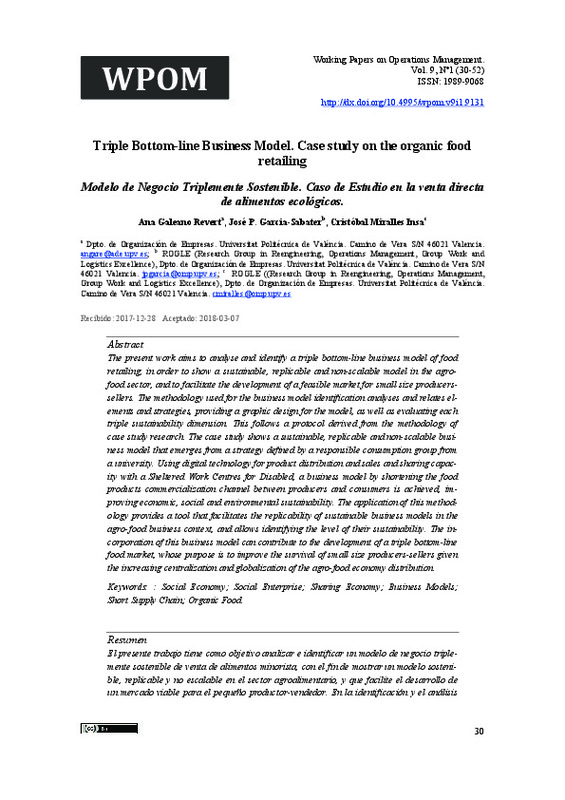Baden-Fuller, C., & Morgan, M. S. (2010). Business Models as Models. Long Range Planning, 43(2-3), 156-171. http://doi.org/10.1016/j.lrp.2010.02.005
Bagnoli, L., & Megali, C. (2009). Measuring performance in social enterprises. Nonprofit and Voluntary Sector Quarterly., 40(1), 149-165. https://doi.org/10.1177/0899764009351111
Barney, J. B., & Hesterly, W. (2015). Strategic management and competitive advantage concepts and cases. Pearson.
[+]
Baden-Fuller, C., & Morgan, M. S. (2010). Business Models as Models. Long Range Planning, 43(2-3), 156-171. http://doi.org/10.1016/j.lrp.2010.02.005
Bagnoli, L., & Megali, C. (2009). Measuring performance in social enterprises. Nonprofit and Voluntary Sector Quarterly., 40(1), 149-165. https://doi.org/10.1177/0899764009351111
Barney, J. B., & Hesterly, W. (2015). Strategic management and competitive advantage concepts and cases. Pearson.
Busch, G., & Spiller, A. (2015). Farmer share and fair distribution in food chains from a consumer's perspective. Journal of Economic Psychology, 55, 149-158. http://doi.org/10.1016/j.joep.2016.03.007
Casadesus-Masanell, R., & Ricart, J. (2010). From Strategy to Business Models and onto Tactics. Long Range Planning, 43(2-3), 195-215. http://doi.org/10.1016/j.lrp.2010.01.004
Chatterjee, S. (Author). (2013). Simple Rules for Designing Business Models. California Management Review. Winter2013, 55(2), 97-124. 28p. 1 Black and White Photograph. http://doi.org/10.1525/cmr.2013.55.2.97
Dittrich, P. (funcionaria federal de agricultura de la C. S. (2010). Agricultura ecológica. Nota informativa. Retrieved from https://ec.europa.eu/europeaid/sites/devco/files/study-organic-agriculture-201206_es_5.pdf
Elkington, J. (2004). Enter the triple bottom line. The Triple Bottom Line: Does It All Add up, 11(12), 1-16.
Galeano Revert, AM. (2013). Identificar y analizar modelos de negocio a través de la metodologia de los casos de estudio. Una revision del estado del arte y propuesta premilinar. Universitat Politècnica de València. http://hdl.handle.net/10251/35065
Galeano Revert, AM. (2017). Propuesta de metodologia para la identificacion y el analisis de modelos de negocio triplemente sostenibles en el sector agroalimentario (Tesis doctoral no publicada) Universitat Politècnica de València. https://doi.org/10.4995/Thesis/10251/88395
Galli, F., & Brunori, G. (2013). Short Food Supply Chains as drivers of sustainable development. Evidence Document. Evidence Document. Retrieved from http://www.foodlinkscommunity.net/fileadmin/documents_organicresearch/foodlinks/CoPs/evidence-document-sfsc-cop.pdf
Garcia-Sabater, J., & Garcia-Sabater, J. P. (2017). Fundación Espurna: A Case Study on Social Entrepreneurship. In Social Entrepreneurship in Non-Profit and Profit Sectors (pp. 73-83). Springer International Publishing. https://doi.org/10.1007/978-3-319-50850-4_6
Grassl, W. (2012). Business Models of Social Enterprise: A Design Approach. ACRN Journal of Entrepreneurship Perspectives, 1(1), 37-60.
Hopwood, B., Mellor, M., & O'Brien, G. (2005). Sustainable development: mapping different approaches. Sustainable Development, 13(1), 38-52. https://doi.org/10.1002/sd.244
Hubbard, G. (2009). Measuring organizational performance: beyond the triple bottom line. Business Strategy and the Environment, 18(3), 177-191. https://doi.org/10.1002/bse.564
Lee, J. H., Shin, D. I., Hong, Y. S., & Kim, Y. S. (2011). Business Model Design Methodology for Innovative Product-Service Systems: A Strategic and Structured Approach. 2011 Annual SRII Global Conference, 663-673. https://doi.org/10.1109/SRII.2011.72
Malthus, T. R. (1846). Ensayo sobre el principio de la población. (L. Gonzalez., Ed.).
Mikhalkina, T., & Cabantous, L. (2015). Business Models and Modelling. (C. Baden-Fuller & V. Mangematin, Eds.)Advances in Strategic Management (Vol. 33). Emerald Group Publishing Limited. http://doi.org/10.1108/S0742-3322201533
Miralles Insa, C., & Puchades Pla, R. (2016). La Universidad y su rol en la integración laboral . Visión global y experiencias locales en la UPV, 1-19.
Monzón, J. L. (2006). Economía Social y conceptos afines: fronteras borrosas y ambigüedades conceptuales del Te rcer Sector. CIRIEC-España, Revista de Economía Pública, Social Y Cooperativa, 56, 9-24.
Monzón Campos, J. L. (2013). Social enterprises and social economy: Their boundaries and methodological proposals for measuri ng their socioeconomic impact in the E.U. | Empres as sociales y economía social: Perímetro y propues tas metodológicas para la medición de su i mpacto socioe. Revista de Economia Mundial, (35).
Norman, W., & MacDonald, C. (2004). Getting to the bottom of "triple bottom line. Business Ethics Quarterly, 14(2), 243-262. https://doi.org/10.5840/beq200414211
Ricart, J., & Casadesus-Masanell, R. (2011). How to design a winning business model. Harvard Business Review, 89, 1-2.
Sandhu, S., & Harris, H. (2014). Linking Local and Global Sustainability (The Intern). Springer Netherlands.
Savitz, A. W., & Weber, K. (2006). The triple bottom line. In J.-B. 320 San Francisco (Ed.), .
Sorescu, A., Frambach, R. T., Singh, J., Rangaswamy, A., & Bridges, C. (2011). Innovations in Retail Business Models. Journal of Retailing, 87, S3-S16. http://doi.org/10.1016/j.jretai.2011.04.005
Ucaktürk, A., Bekmezci, M., & Ucaktürk, T. (2011). Prevailing During the Periods of Economical Crisis and Recession through Business Model Innovation. Procedia - Social and Behavioral Sciences, 24, 89-100. http://doi.org/10.1016/j.sbspro.2011.09.095
Wandemberg, J. C. (2015). Sostenible por diseño: desarrollo económico, social y ambiental. CreateSpace.
Yin, R. K. (2013). Case study research: Design and methods. Sage Publications.
Zott, C., Amit, R., & Massa, L. (2011). The business model: Recent developments and future research. Journal of Management, 37(4), 1019-1042. http://doi.org/10.1177/014920631140626
[-]








